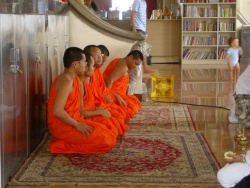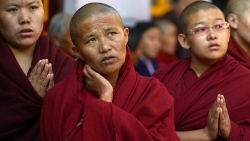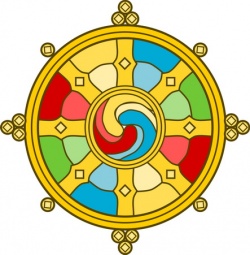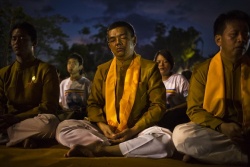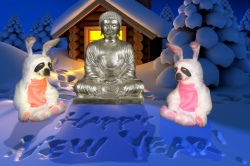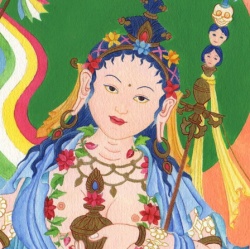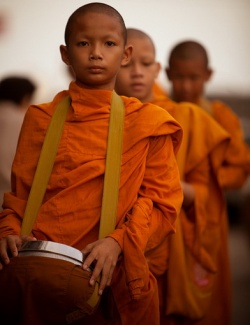Buddhism, Schools of: Chinese Buddhism
Chinese Buddhism is typically described in terms of schools, a word used variously to refer to lineages of exegetical interpretation, styles of devotional or cultivational practice, or combinations of both. The earliest schools to emerge, from the fifth century onward, were exegetical lineages devoted to the interpretation of individual scriptures or groups of scriptures. Early examples include traditions based on Chinese translations of Mādhyamika or Yogācāra treatises, as well as on individual scriptures such as the Nirvāṇa Sūtra. A tendency to greater conceptual inclusiveness culminated in the development of the systematic schools, often referred to as Sui-Tang schools because of the timing of their emergence during those dynasties (sixth to eighth centuries); primary examples are the Tiantai and Huayan (Flower Garland) traditions. At about the same time or slightly later there also developed identifiable modes of practice or modal traditions, so named because of the centrality of different forms of religious praxis to their identities; this refers to Pure Land devotionalism, Chan (Zen) meditation and dialogue practices, and esoteric Buddhist ritual endeavor.
TERMINOLOGY
The English term school evokes the philosophical traditions of ancient Greece, in which individual teachers guided small assemblies of (predominately male) students in different styles of intellectual discourse. This usage privileges individual founders and doctrinal content over social features and religious praxis, and it implies a historical model that is of limited application to the exegetical schools and individual monastic communities of Chinese Buddhism, and is at best unwieldy when used for other types of Buddhist schools.
Japanese scholarship and the Japanese denominational model have had a significant and often unrecognized influence on Western-language interpretations of Chinese Buddhism since the late nineteenth century. Japanese scholars such as Nanjō Bun'yū (1849–1927) and Takakusu Junjirō (1866–1945) worked as students and research assistants with major scholars such as Max Müller (1823–1900) and Sylvain Lévi (1863–1935), respectively, during the formative years of European Buddhist studies and religious studies. Adopting their mentors' perspective on the importance of the Buddha as founder and of doctrine as his primary contribution, these Japanese authors and their later colleagues described Chinese Buddhism in terms of the founders, doctrines, and characteristic practices of the separate denominational entities that had crystallized in Japan during the Tokugawa period (1600–1868), when the Japanese government had imposed a fixed administrative structure on the religion there. Although this was an understandable projection of early Japanese Buddhology, it is important to remember that nothing like a Japanese "school," as an integrated denominational organization with prescribed doctrines and practices and clearly defined institutional assets, priestly specialists, and lay membership, ever existed in Chinese Buddhism.
There are also profound differences between the "schools" of Chinese Buddhism and those of the parent Indian tradition, where the various nikāyas (e.g., Dharmaguptaka, Sarvāstivāda) functioned as ordination lineages and only secondarily as exponents of particular doctrinal stances. It is somewhat more appropriate to use the philosophical identifiers Mādhyamika, Yogācāra, and so on to identify pan-Asian styles of interpretation, although there were no institutional links between Indian and Chinese adherents of such philosophical "schools," and participants in these philosophical traditions in the two cultures worked from very different sets of texts.
In contrast, ordination lineage was rarely if ever used as a sectarian identifier in China. Only a few different sets of Vinaya regulations were ever in use there, and from at least the seventh century on all Chinese Buddhist monks and nuns were ordained under the same set of monastic regulations translated from those of the Indian Dharmaguptaka ordination lineage. In addition, as far as we can tell, virtually all Chinese Buddhists, even those who specialized in the study of treatises labeled Hīnayānist in the East Asian tradition (such as the widely read Abhidharmakośa of the Sautrāntika-Sarvāstivāda authority Vasubandhu, for example), identified themselves with the Mahāyāna. In addition, the number of foreign missionaries who identified strongly with the non-Mahāyāna was extremely small. Thus, usingPage 1236 | Top of Article the terminology commonly applied to Indian Buddhism, all Chinese Buddhists belong to a single "school"—not a particularly helpful usage.
Finally, the rhetoric of sect, which is used in the literatures of sociology and religious studies to refer either to nonmainstream movements that challenge the status quo or to highly organized entities that prescribe totalistic programs of religious involvement for their members, is entirely inappropriate for the description of Chinese Buddhism prior to the emergence of the White Lotus Teaching and other popular movements of the fourteenth century and after.
EXEGETICAL LINEAGES
During the first four centuries of the common era, there was a gradually increasing number of Buddhist adherents and communities in China, but nothing that achieved the continuity or impact to be recognized as a distinctive school. This is true even of the highly esteemed Huiyuan (334–416), whose community on Mount Lu represented the ideal of early monastic life but did not continue to function as a coherent group after the master's death. Thus, even though Huiyuan is famous for having led a group of 123 clergy and laypeople in meditative devotions to the Buddha Amitābha of the Pure Land, this was but one event within a broader fabric of activities. Although important as a historical precedent to the later Pure Land tradition, which dogmatically claims him as a founding "patriarch," this cannot be considered the beginning of a Chinese Pure Land "school."
Given the foundation of those first four centuries, the early fifth-century output of the great translator and exegete Kumārajīva (d. 409) provided Chinese Buddhists with the textual resources for the sophisticated understanding of their chosen tradition. In addition, Kumārajīva attracted a number of gifted monks, who studied with him and assisted with the editing and explanation of the newly translated texts. Many of his texts thus became the foci of significant exegetical activity, with his own students writing widely read interpretive essays and commentaries. Such lineages of study constitute the earliest hints of sectarian differentiation in Chinese Buddhism.
As Stanley Weinstein (1987) has observed, of the ten texts most commonly studied in south China during the fifth century, seven had been translated by Kumārajīva. Four of these were sūtras: the Lotus of the Wondrous Dharma (Miaofa lianhua jing, Saddharmapuṇḍarīka-sūtra); Teaching of Vimalakīrti (Weimojie jing, Vimalakīrtinirdeśa-sūtra); Perfection of Wisdom (in two versions: Bore jing, Prajñāpā-ramitā-sūtra); and Ten Stages [of the Bodhisattva) (Shizhu jing, Daśabhūmika-sūtra). In addition, Kumārajīva produced a recension of the Vinaya known in Chinese as the Ten-Recitation Vinaya (Shisong lü), which derived from that of his own Sarvāstivāda ordination lineage. He also translated scholastic discourses, including an exposition of Buddhist analytical philosophy called Treatise on the Perfection of Truth (Chengshi lun, Satyasiddhi-śāstra), which later came to be viewed as anomalous because of its simplistic explanation of śūnyatā or "emptiness," and three Mādhyamika texts that came to be known collectively as San lun or Three Treatises. Kumārajīva's translation of the Commentary on the Great Perfection of Wisdom (Da zhidu lun, popularly called Da lun, *Mahāprajñāpāramitopadeśa), although completed in 405, was largely ignored until the second half of the sixth century, when its study was taken up by scholars in the San lun tradition. The three other major texts studied in fifth-century south China were the Nirvāṇa Sūtra (Niepan jing), translated by Dharmakṣema in 421 and revised slightly by southern scholars shortly thereafter; the Treatise on the Essence of the Abhidharma (Za apitan xin lun, popularly referred to as Pitan, *Saṃyuktābhidharmahṛdaya-(śāstra)), translated by Saṃghavarman around 435; and the Sūtra of the Lion's Roar of Queen Śrīmālā (Shengman jing, Śrīmālādevīsiṃ-hanāda-sūtra), translated by Guṇabhadra in 436.
In the north, dynastic wars in the 420s and 430s and a persecution of Buddhism in the 440s made continued scholarly activity difficult. When lecturing on the scriptures and commentarial writing resumed in the last decades of the fifth century, monks there focused primarily on texts that had been ignored in the south or which had only recently been translated. The most prominent exception was the Nirvāṇa Sūtra, which was the subject of massive commentarial attention both in the north and at the court of Liang Emperor Wu (r. 501–549) in southern China. Texts studied in the north but largely ignored in the south include the Flower Garland Sūtra (Huayan jing, Avataṃsaka) translated by Buddhabhadra in 420; the Sūtra on the Bodhisattva Stages (Pusadichi jing, Bodhisattvabhūmi Sūtra), translated by Dharmakṣema in 418; and the Four-Part Disciplinary Code (Sifen lü), the Vinaya recension deriving from the Dharmaguptaka ordination lineage and translated by Buddhayaśas and Zhu Fonian in 405 or 408. Of the texts appearing for the first time in translation in the first half of the sixth century, the one that attracted the greatest attention in north China was the Commentary on the Sūtra of the Ten Stages (Shidi jing lun, commonly called Di lun), translated by Bodhiruci and others in 511. Learned monks in south China in the second half of the sixth century were similarly attracted by the Compendium of the Mahāyāna (She dasheng lun, Mahāyānasaṃgraha, commonly called She lun) and the Treasury of the Abhidharma (Apidamo jushe shi lun, Abhidharmakośa), both translated by Paramārtha in 563.
The exegetical lineages devoted to each of these texts (or sets of texts, in the case of the San lun) constituted "schools" only in the most minimal sense. In the first place, although individual monks were known as specialists in particular scriptures, most seem to have worked on multiple texts of various types. Second, although the lineage of study of any text might be traceable from one generation to the next, even when a student's interpretation borrowed heavily from his teachers such connections were overwhelmed by the fluctuations in popularity of different scriptures over the decades. Third, monks often studied with multiple teachers, so thatPage 1237 | Top of Article exegetical lineages often "cross-pollinated" each other. Fourth, far from attempting to keep scriptural traditions distinct and independent, the interpretations of individual scriptures were played against each other, with the understanding of one scripture used as a guide for the analysis of totally different texts, and the understanding of Buddhism as a whole applied to the line-by-line interpretation of specific scriptures.
Weinstein concludes that for fifth- and sixth-century China there were five principle exegetical traditions based on Indian treatise literature: Chengshi lun, Di lun, San lun (including study of the Commentary on the Great Perfection of Wisdom), Pitan (Abhidharma), and She lun. To this we might add the exegetical traditions based on sūtra and Vinaya literature—Lü (Vinaya), Nirvāṇa, and Huayan—the result being the set most often referred to as "schools" in modern writings.
The term sometimes used in contemporaneous Chinese writings to describe these traditions of monkish learning, zong (which in Chinese originally referred to a clan temple, or the clan's primal ancestor or ancestral deity, and by extension the clan as a whole), referred not to any kind of sectarian identity but to the "underlying theme" or "essential doctrine" of the text in question. Indeed, at the very end of the sixth century several "[study] group leaders" (zhongzhu) specializing in particular texts were accorded formal recognition by the Sui dynasty (589–618) government, with Emperor Wen (r. 581–605) assigning eminent monks residence at different major temples in Chang'an as leaders of the Di lun, Vinaya, Da lun (i.e., Da zhidu lun), and Niepan study groups, respectively. Based in part on this precedent, the teachings of all these exegetical traditions were transmitted to Japan before or during the Nara period (710–784), where their use as sectarian labels became institutionalized within Japanese Buddhism. However, as Abé Ryūichi has shown, even the study groups of Nara Buddhism were very small assemblies with overlapping memberships and entirely without administrative authority or institutional identity, so that the rhetoric of "school" is problematic in this case as well.
SYSTEMATIC SCHOOLS
A qualitative change in the nature of Chinese Buddhist schools occurred through the efforts of Tiantai Zhiyi (538–597). Zhiyi's wide-ranging discussion of a number of major Chinese scriptures, integrated interpretation of Buddhism from the perspective of the very popular Lotus Sūtra, and intimate connections with the founders of the Sui dynasty led to the establishment of one of the most influential and long-lasting schools of East Asian Buddhism. The tradition he established came to be known as the Tiantai school, based on the name of the mountain in southeastern China (Zhejiang province) chosen as his major center; it also flourished in Korea (as the Ch'ŏnt'ae school) and Japan (as the Tendai school). Although the Tiantai school fell out of favor during the early years of the Tang dynasty (618–906), it was "revived" by Zhiyi's fifth-generation successor Zhanran, who was in fact the first to refer to his tradition as "Tiantai school." Later, Tiantai flourished to the extent of becoming effectively synonymous with all "teaching" monasteries (roughly 5 percent of all major public institutions) from the Song dynasty (960–1279) onward.
Zhiyi's innovation was to combine (1) a set of interpretative schema intended to govern all Buddhist doctrine (as available in the East Asian subcontinent at the time); (2) a similarly comprehensive system of meditation practice; and (3) a specific institutional center and teaching lineage. One of the core elements of his teachings was the philosophy of emptiness (śūnyatā) derived from Nāgārjuna's writings, particularly the Mūla-madhyamaka-kārikā, represented in Chinese as the Zhong lun (Treatise on the Middle), one of the San lun or "three treatises," and the Commentary on the Great Perfection of Wisdom, also attributed to Nāgārjuna but more likely a compilation by the translator Kumārajīva. This was combined with a multifaceted use of the Lotus Sūtra, both for its doctrinal implications and as inspiration for repentance ritual and meditation practice. From this scripture Zhiyi adopted the position that the various teachings of the Buddha were directed at sentient beings at different levels of spiritual capacity, using "skillful means" (upāya, fangbian) to adapt his message to the listener. Given this theoretical basis, and drawing extensively on the work of earlier Chinese commentators, Zhiyi outlined the "five times"—five separate periods of the Buddha's teaching career—as well as different types of doctrine and methods of teaching used by the Buddha in different contexts. Although the details of this formulation cannot be included here, its implications were immense: Zhiyi provided a comprehensive explanation for the sometimes jarring differences between Buddhist scriptures, claiming that each different doctrinal message was intended to lead diverse congregations of followers upward to the single goal of buddhahood. In generating this schema Zhiyi built on earlier interpretations to signal the importance of such widely used texts as the Flower Garland, Perfection of Wisdom, Vimalakīrti, and Nirvāṇa sūtras, even while according his favored Lotus Sūtra pride of place as the very pinnacle of the Buddha's teachings. Zhiyi was similarly inclusive and systematic in the realm of meditation practice, defining four categories of samādhi that covered virtually all possible approaches: constantly seated, constantly walking, mixed seated and walking, and neither seated nor walking. Indeed, his concrete prescriptions for so many different types of meditation practice became the standard set of guidelines for all Chinese Buddhists for the next several centuries.
In terms of lineage identity, Zhiyi considered himself to represent, not one of multiple sectarian units within Buddhism, but the most profound teachings of Buddhism itself, as transmitted from Śākyamuni through the Indian Mādhyamika philosopher Nāgārjuna (fl. 2nd c. CE) to his own Chinese teachers and then himself. Zhiyi's fifth-generation successor, Zhanran, was the first to use the term "Tiantai school" (Tiantai zong), defending its superiority over other emergent schools of his day, and here the wordPage 1238 | Top of Article zong takes on a new connotation of the essential teaching of Buddhism as transmitted through a specific lineage from the Buddha Śākyamuni. The sense of transmission from one "golden-mouthed" master to another in this system was notably abstract, and it was only with the development of the Chan school (see below) that a much more concrete and straightforward succession of patriarchs emerged. Later developments in Chinese Tiantai include the emergence of "home-mountain" and "off-mountain" factions in the Song dynasty, with monks based either on Mount Tiantai or elsewhere generating different interpretations of Zhiyi's teachings. Korean scholar-monks in the eleventh and twelfth centuries combined Zhiyi's various formulations into a neatly organized doctrinal system, and this system came to be widely accepted in medieval Japan and later Chinese Buddhism.
Inspired by Zhiyi's example, Chinese representatives of the Yogācāra and Huayan (Flower Garland) traditions sought to attract imperial support through similarly comprehensive interpretations of Buddhist doctrine. The great pilgrim and translator Xuanzang (600?–664) and his disciple Ci'en (Dasheng Ji, often referred to, probably inaccurately, as Kuiji; 632–682) introduced a substantial body of new texts as the basis of the so-called Faxiang school, while Fazang (643–712) built upon a tradition of scholarly and inspirational writing based on the Huayan or Flower Garland Sūtra to attract the support of Empress Wu (r. 690–705). The Faxiang (a widely used label in modern times, although it actually derives from the Japanese name Hossō) and Huayan (Jpn. Kegon) schools were extremely important in Nara-period Japan, and they remained important in different ways on the continent as well. Yogācāra was recognized for its doctrinal innovations regarding the nature of human consciousness and phenomenal reality, even though its specific positions never achieved widespread currency (in part through their philosophical complexity and in part through their contrast with Chinese preferences for more inclusive, even universalistic, doctrines). The Huayan school was similarly recognized for its elaboration of the mutual interpenetration of all phenomena (often using lists of mind-numbingly abstruse distinctions), but unlike Chinese Yogācāra it had a continuing legacy of visionary meditation and ritual practice that was accessible to accomplished scholars and ordinary people alike.
The systematic schools that appeared in the sixth to eighth centuries had enduring presences throughout the balance of Chinese (and, indeed, East Asian) Buddhist history. What sets these schools apart from the earlier exegetical lineages, as well as from other contemporaneous movements, was their particular combination of imperial support, religious breadth, and position within the textual tradition. In the first place, the founders of these schools all received unique levels of attention from the imperial rulers of their day. Zhiyi, for example, received special attention from the Sui dynasts as part of their campaign to conquer south China, while Xuanzang merited extraordinary acclaim because of his knowledge of the "western regions" and prodigious output as a translator. Fazang, for his part, was recognized as a precocious young monk and actively promoted by Empress Wu.
Second, although the Tiantai, Faxiang, and Huayan systems all had their distinctive emphases, each possessed a certain capaciousness that allowed for participation in different ways. The primary example of this is Zhiyi, whose encyclopedic attentions to the grand variety of Buddhist doctrine and meditation practice seemed to make a place for everyone and every approach. With his mastery of the latest trends in Indian Yogācāra, Xuanzang (and Ci'en) felt empowered to generate a comprehensive interpretation of Buddhist doctrine, which specified different alternatives available for those at different stages on the spiritual path. For his part, Fazang's presentations of abstract tenets proved highly attractive to Chinese Buddhists at the time and in subsequent generations, allowing both highly intellectual philosophical responses and strongly visionary approaches to meditation practice.
Third, the capacious quality just described was made possible in each case by magisterial control of a given body of Buddhist scripture. The Lotus and Flower Garland sūtras were arguably the most popular large scriptures in China during the preceding several centuries, and the various texts of the Yogācāra made it one of the most important modes of intellectual interpretation. Although Zhiyi was not directly involved with the enterprise of translation, and Fazang only to a limited degree, the connection of all three men with the imperially sponsored domain of Buddhist scriptural production should not be overlooked.
Thus each of the systematic Sui-Tang schools represented a comprehensive doctrinal system, complete with a lineage-based justification of its transmission from the Buddha, and a characteristic set of positions regarding spiritual cultivation. We should remember, though, that the elite monks identified with these systematic schools were but a tiny fraction of the Chinese monastic community.
MODAL TRADITIONS
In the seventh and eighth centuries, three modes of religious practice emerged that were to become enduring features of Chinese Buddhism: Pure Land devotionalism, Chan (better known by the Japanese pronunciation "Zen") meditation, and esoteric Buddhist (mijiao) visualization ritual. While very different from each other in terms of soteriological goals, devotional procedures, and ritual styles, these three modal traditions all (1) emphasized selected approaches to religious practice rather than attempting to be theoretically comprehensive; (2) allowed for great practical variation and participation by a wide range of individuals, from ordinary laypeople to sophisticated monks; and (3) had much more limited, and sometimes even antagonistic, relationships with Buddhist scriptural traditions.
The Chinese Pure Land tradition is based on a set of translated scriptures describing the Buddha AmitābhaPage 1239 | Top of Article ("Infinite Light," also given as Amitāyus, "Infinite Lifespan") and his paradise, the "pure land" (jingtu) or "land of bliss" (reflecting the Sanskrit sukhāvatī). Through his aeons of religious cultivation as the Bodhisattva Dharmākara, Amitābha created a realm totally unlike the ordinary world-systems of Buddhist cosmology, including their heavens, in making it easy for those reborn there to achieve enlightenment. Amitābha promised that those who were "mindful" (nian, "remember, think," from the Sanskrit anusmṛti) of him for a mere ten moments of thought were guaranteed rebirth in his Pure Land. This was initially understood as an easy form of meditative visualization, in which one was aided by the graphic concreteness of the Buddha's image. As mentioned above, this type of visualization was practiced at one time at Huiyuan's community on Mount Lu.
During the sixth and seventh centuries, at Xuanzhongsi in north China (Shanxi province), there appeared a succession of monks who transformed the understanding of Pure Land practice, expanding it from the original visualization meditation just described to include ever greater emphasis on the oral recitation of the Buddha Amitābha's name. Tanluan (c. 488–c. 554) emphasized that Pure Land practice was an easy path suitable for people living in a corrupt world, while Daochuo (562–645) argued that this practice was particularly appropriate for the final period of the Buddhist teachings (mofa; Jpn. mappō), since it would result in a face-to-face meeting with Amitābha at death. Since he also held that it was impossible to know when one achieved the requisite ten moments of pure sincerity in performing the nianfo (literally, "mindfulness of the Buddha," almost always indicating Amitābha), Daochuo also directed his followers to perform as many oral repetitions as possible. Although Shandao (613–682) recommended the combined practice of sūtra recitation, visualization of Amitābha, and worshiping Buddha images, his primary emphases were that Pure Land practice was intended precisely for the ignorant and sinful, rather than the spiritually gifted or advanced, and that it consisted primarily of oral recitation. He also provided detailed instructions for how nianfo retreats were to be undertaken, either as ordinary religious practice aimed at liberation or as deathbed observations aimed at ensuring immediate rebirth.
Although these and other Chinese Pure Land masters were accomplished scholars, their commentaries and treatises argued that devotion to Amitābha could substitute for, rather than encompass and incorporate, other forms of Buddhist religiosity. Shandao in particular also promoted this style of devotionalism by the widespread distribution of painted images of Pure Land scenes and the sponsorship of sculpted images of Amitābha and his attendant bodhisattvas. Nor were these the only Tang-dynasty proponents of Pure Land Buddhism. Meditation on Amitābha was included within Zhiyi's "constantly walking" samādhi, which thus became the most widely practiced of the four categories in his system, and the increasing popularity of the recitation of Amitābha's name led to the development of musical styles of recitation. This occurred most notably on Mount Wutai in Shanxi, from which the melodic recitation of Amitābha's name was transmitted to Japan by the famous pilgrim Ennin (794–864) and others. Since the Pure Land represented a paradise that could be reached after death, this practice became a key ingredient of deathbed observances, and there soon developed stories depicting devoted individuals who had achieved rebirth in Amitābha's land of bliss. Since there was no clear-cut distinction between meditative and recitative nianfo, ordained and lay Buddhists of widely different social and educational backgrounds could all take part in the practice.
The word Chan transcribes the Sanskrit dhyāna, meaning "concentration meditation." Chan has its roots in the meditation traditions of fifth-century Kashmir, but it first emerged as a discernable religious movement in the sixth and early seventh centuries as a north China group of ascetic practitioners who recognized the south Indian monk Bodhidharma (d. circa 530) as their progenitor. Then, after three-quarters of a century of incubation at various locations in central China, in 701 the movement emerged on the national scene at the court of Empress Wu. Many of the basic doctrines now associated with Chan were formulated in the early years of the eighth century, and the most famous of the school's masters were active in central and south China in the late eighth and ninth centuries. It was not until after the fall of the Tang, however, in the Min regime of the far southeast (in what is now Fujian province), that the most distinctive features of the school—chiefly, its devotion to spontaneous repartée between masters and students, known as "encounter dialogue"—became public. Then, with the founding of the Song dynasty in 960, Chan became one of the dominant voices of Chinese Buddhism, its teachers monopolizing the position of abbot in nine-tenths of the largest monasteries throughout the country and its genealogically based style of self-understanding becoming the default mode of religious discourse.
The key to understanding Chinese Chan is its lineage schema, which proved to be far more compelling than the Tiantai school's abstract and discontinuous list of sages introduced above. Based in part on Indian notions of master-student succession, Chan held that the true teaching of Buddhism was passed down from the Buddha Śākyamuni through a succession of Indian patriarchs to Bodhidharma, and then by a succession of Chinese patriarchs to the teachers of the present day. Since the doctrinal elaborations of the scriptures were unable to capture the true essence of this teaching, Chan rejected the textual tradition that had been so important in Chinese Buddhism for all previous schools, defining itself instead as a "separate transmission outside the scriptures" (jiaowai bie zhuan; Jpn. kyōge betsuden). This genealogical model is also the key to understanding Chan religious praxis, which was undertaken largely according to two different models. In the Caodong (Jpn. Sōtō) tradition, one was to nourish the buddha-mind within one (i.e., one's buddha-nature, or the quality of originary or fundamental enlightenmentPage 1240 | Top of Article in all sentient beings) to illuminate with its full potential, unhampered by the illusions of ordinary existence, a process known sometimes as "silent illumination" (mozhao; Jpn. mokushō). In the Linji (Jpn. Rinzai) tradition one was to demonstrate the active functioning of that buddha-mind in spontaneous interaction between enlightened master and aspiring student or, in later years, to interrogate famous examples of such interaction in one's meditation practice. The type of spontaneous and often nonverbal interaction depicted in Chan texts is known as "encounter dialogue," and the contemplation of pithy examples of encounter dialogue is known as "viewing the critical phrase" (kanhua; Jpn. kanna) Chan (often referred to, using the Japanese pronunciation, as kōan Zen), where the "critical phrase" is the climactic line of an anecdote that can only be understood by transcending ordinary thinking.
As an ideology of self-cultivation by religious professionals, Chan (unlike Pure Land) always remained centered within monastic institutions. Nevertheless, it attracted substantial literati interest, and its unique style of repartée was celebrated in diverse contexts of art and poetry, so that the image of the iconoclastic Chan master entered the shared repertoire of Chinese culture. Its genealogical model and iconoclastic tropes placed it in contrast with traditional forms of Buddhism, and Chan was able to flourish in part because it filled a vacuum left by the collapse of the state-supported translation enterprise after the end of the eighth century.
Esoteric Buddhism (mijiao) was introduced to China by three foreign missionaries in the eighth century: Śubhākarasiṃha (637–735), who arrived in Chang'an in 716; Vajrabodhi (671–741), who arrived in Guangzhou (Canton) in 720; and Amoghavajra (705–774), who became a disciple of Vajrabodhi's at age fifteen in China, traveled to India after his master's death, and returned to China in 746. Whereas magic-like techniques of recitation, visualization, and ritual had long been known from Indian sources, it was only from this period onward that there was introduced a comprehensive system of these techniques organized by the spatial metaphor of the maṇḍala (literally "circle," here referring to concentric configurations of buddhas, bodhisattvas, and other deities). Promising both speedy achievement of enlightenment and the empowerment for ritual action by the most profound and awesome forces of the universe, esoteric Buddhism overwhelmed the imaginations of eighth-century Chinese and received lavish support from the imperial court.
Although the texts and ritual procedures introduced by these three masters, with the assistance of their gifted Chinese disciple Yixing (683–727), made a massive contribution to the ritual vocabulary of Chinese Buddhism that permeated the entire tradition, esoteric Buddhism gained only a limited acceptance in China as a distinct and separate school. Its advocates never produced intellectually substantial doctrinal statements, either of Indian or native Chinese origin (although there was a brief flurry of new texts introduced in the last two decades of the tenth century), and even its two separate initiation lineages seem not to have been transmitted after the ninth century. Where Chan effectively benefited from the collapse of the translation enterprise, as an incipient systematic school (which it became in Japan, through the creative efforts of Kūkai) esoteric Buddhism floundered in China.
LATER DEVELOPMENTS
From the Song dynasty (960–1279) onward new subschools emerged in Chinese Buddhism, and some of the major schools took on each other's characteristics. First, various "houses" and other sublineages developed with Chan, which retained its dominance in monastic institutions throughout the country. Second, Pure Land Buddhism began to describe itself by means of a lineage succession, a style of presentation adopted from Chan. Third, the Tiantai school witnessed competition between "home-mountain" (shanjia) and "off-mountain" (shanwai) factions, identified by their residence on Mount Tiantai or elsewhere and characterized by different understandings of Zhiyi's teachings. Fourth, Tibetan Buddhism flourished for a time during the Yuan dynasty (1206–1368) and again during the Qing (1644–1911), especially at court, though anti-Mongol sentiments limited its more widespread dissemination. Fifth, there were numerous vectors of religious activity in Chinese Buddhism not normally considered discrete sectarian entities but which might usefully be considered in the same context; a primary example is the diffuse but extremely popular cult devoted to the salvific Bodhisattva Avalokiteśvara (known as Guanyin, Guanshiyin, Guanzizai, and other names in Chinese). Even granting these features, however, the sectarian labels that emerged during the Tang dynasty have remained in widespread use throughout the rest of Chinese history.
SEE ALSO
Bodhidharma ; Buddhism, article on Buddhism in China ; Fazang ; Huayan ; Kuiji ; Kumārajīva ; Mādhyamika ; Tiantai ; Yogācāra ; Zhiyi .
BIBLIOGRAPHY
The most important source for the understanding of Chinese Buddhist schools is Stanley Weinstein's masterful article on the subject in the first Encyclopedia of Religion (New York, 1987), vol. 2, pp. 482–487, which also provides useful references to Chinese and Japanese secondary works. For background information on the systematic schools and other topics, readers should also consult Weinstein's Buddhism under the T'ang (Cambridge, U.K., 1987). Although outdated, Kenneth K. S. Ch'en's Buddhism in China: A Historical Survey (Princeton, N.J., 1964) contains a wealth of generally reliable information. For an example of the early Japanese presentation of East Asian Buddhist schools, see Takakusu Junjirō, The Essentials of Buddhist Philosophy, edited by Wing-tsit Chan and Charles A. Moore (Honolulu, 1947; reprint, New Delhi, 1975). The best guide to interpreting Chinese exegetical lineages may be found in Ryūichi Abé's The Weaving of Mantra: Kūkai and the Construction of Esoteric Buddhist Discourse (New York, 1999). For Song-dynasty Buddhism, see the articles in Peter N. Gregory and Daniel A. Getz, Jr., eds., Buddhism in the Sung (Honolulu, 1999).Page 1241 | Top of Article For issues in later Chinese Buddhism, see Yü Chün-fang, The Renewal of Buddhism in China: Chu-hung and the Late Ming Synthesis (New York, 1981, and Marsha Smith Weidner, ed., Latter Days of the Law: Images of Chinese Buddhism, 850–1850 (Lawrence, Kans., and Honolulu, 1994).
JOHN R. MCRAE (2005)
